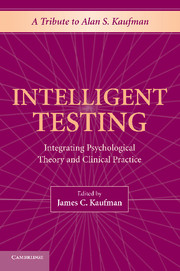Book contents
- Frontmatter
- Contents
- Acknowledgments
- Alphabetical List of Authors and Affiliations
- PART ONE THOSE WHO KNOW HIM
- PART TWO INTELLIGENT TESTING
- PART THREE THE INTERSECTION OF THEORY AND MEASUREMENT
- PART FOUR KAUFMAN ACROSS THE WORLD
- 12 The K-ABC in France
- 13 Dr. Alan Kaufman's Contribution to Japan: K-ABC, Intelligent Testing, and School Psychology
- 14 Alan Kaufman's Deep Influence in Sweden
- 15 Intelligent Testing of Underserved Populations
- 16 Alan S. Kaufman: The Effects of One Man's Extraordinary Vision
- Author Index
- Subject Index
- References
16 - Alan S. Kaufman: The Effects of One Man's Extraordinary Vision
Published online by Cambridge University Press: 05 August 2012
- Frontmatter
- Contents
- Acknowledgments
- Alphabetical List of Authors and Affiliations
- PART ONE THOSE WHO KNOW HIM
- PART TWO INTELLIGENT TESTING
- PART THREE THE INTERSECTION OF THEORY AND MEASUREMENT
- PART FOUR KAUFMAN ACROSS THE WORLD
- 12 The K-ABC in France
- 13 Dr. Alan Kaufman's Contribution to Japan: K-ABC, Intelligent Testing, and School Psychology
- 14 Alan Kaufman's Deep Influence in Sweden
- 15 Intelligent Testing of Underserved Populations
- 16 Alan S. Kaufman: The Effects of One Man's Extraordinary Vision
- Author Index
- Subject Index
- References
Summary
Anne Anastasi described the field of intelligence and intelligence tests as one of the most important contributions psychology has made to society. Whereas early leaders such as Alfred Binet and David Wechsler played a key role in the early development of intelligence tests used today, Alan S. Kaufman is an extraordinary and dynamic psychologist who extended their influence to have a profound influence on the field of psychological assessment and has subsequently distinguished himself as a world leader in the field. Whereas Binet and Wechsler were instrumental in initiating the field, Alan S. Kaufman's provided the field with a vision based upon a scientific approach to intelligence test development and interpretation that have contributed dramatically to the evolution of the field. In addition, Kaufman changed the direction of assessment by applying sound research-based theory to clinical practice via innovative methodology. His influence has been far-reaching and profound, as evidenced by the diverse chapters written by the contributors to this book.
Kaufman began his influence on the field of cognitive assessment in 1969, when he worked closely with Dorothea McCarthy to develop and standardize the McCarthy Scales of Children's Abilities, one of the leading tests for preschool children for more than two decades. In the early 1970s, Kaufman worked closely with David Wechsler and had a profound influence on the development and standardization of the Wechsler Intelligence Scales for Children – Revised. Kaufman significantly influenced the nature and characteristics of these two popular tests.
- Type
- Chapter
- Information
- Intelligent TestingIntegrating Psychological Theory and Clinical Practice, pp. 220 - 234Publisher: Cambridge University PressPrint publication year: 2009



